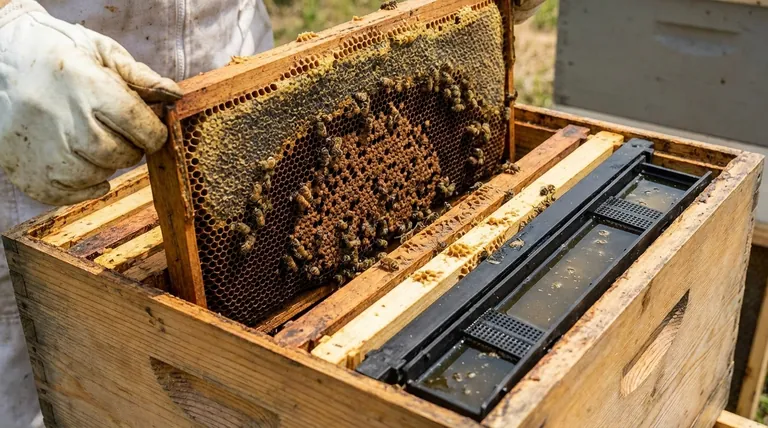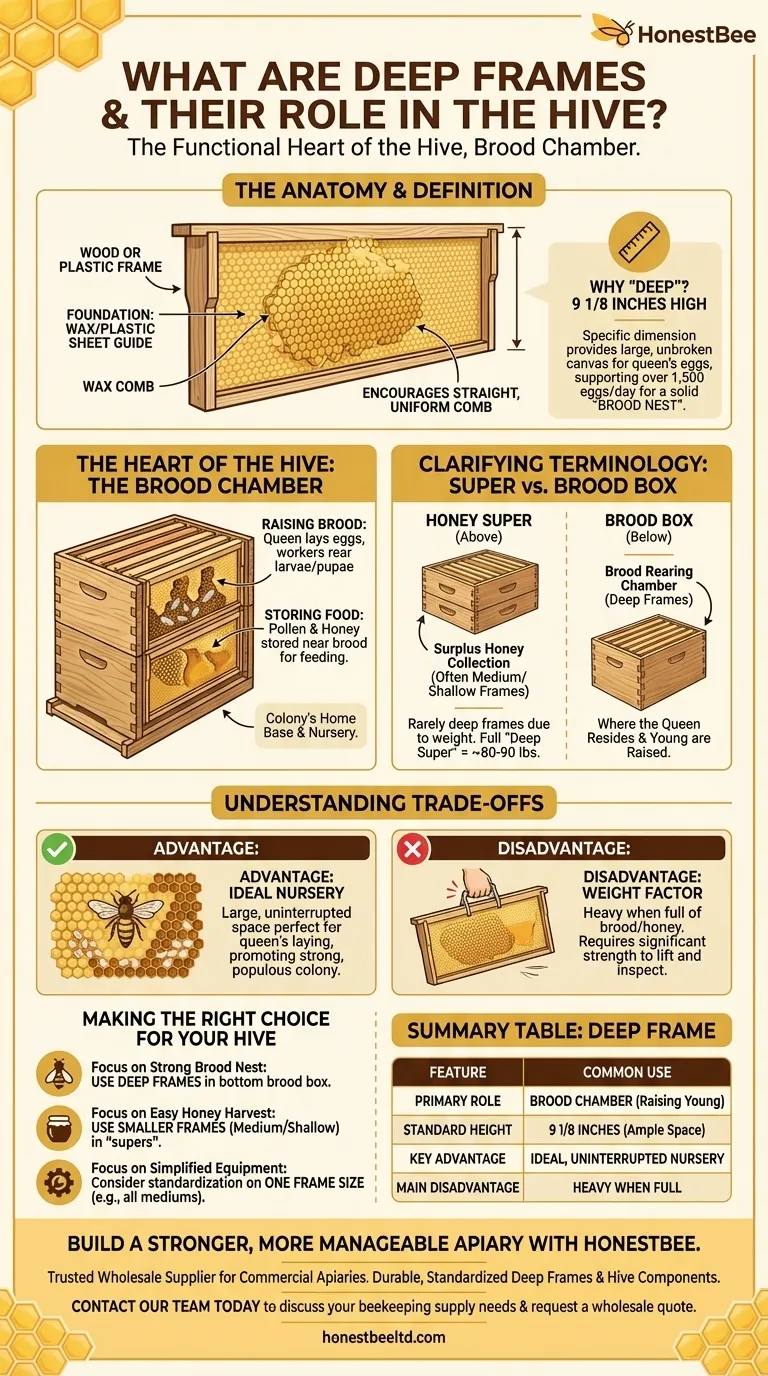In short, deep frames are the internal structures within a beehive where bees build their wax comb. These frames serve as the foundation for the colony's nursery and primary food storage, making them the functional heart of the hive where the queen lays her eggs and the next generation of bees is raised.
The term "deep super frame" can be misleading. These are more accurately called deep frames, and their primary role is not for surplus honey collection (a "super's" job) but for creating the brood chamber—the core of the colony where the queen resides and the hive raises its young.

The Role of the Deep Frame
A beehive is a modular system, and the frames are the key internal components that make it manageable for the beekeeper. A deep frame is defined by its specific size and purpose.
The Anatomy of a Frame
A deep frame is a simple but critical piece of equipment. It consists of a rectangular structure, typically made of wood or plastic, that holds a sheet of foundation.
Foundation is a thin sheet of plastic or beeswax imprinted with the hexagonal pattern of honeycomb. It acts as a guide, encouraging the bees to build straight, uniform comb within the frame's confines. Without it, bees would build comb in irregular patterns, making hive inspections nearly impossible.
Why "Deep"? A Matter of Size
The term "deep" refers to the frame's height, which is standardized at 9 1/8 inches. This specific dimension is not arbitrary.
It provides a large, unbroken canvas for the queen to lay her eggs in a natural, contiguous pattern. A healthy queen can lay over 1,500 eggs per day, and this large area allows her to establish a solid "brood nest" without interruption.
The Heart of the Hive: The Brood Chamber
A set of 8 or 10 deep frames is housed in a box called a deep hive body or, more commonly, the brood box. This is the colony's home base.
Inside the wax cells built on these frames, two critical functions take place:
- Raising Brood: The queen lays her eggs here, and worker bees rear the larvae and pupae.
- Storing Food: Bees store pollen ("bee bread") and honey in cells immediately surrounding the brood to ensure the young are well-fed.
Clarifying the Terminology: "Super" vs. "Brood Box"
The term "super" can cause confusion. In beekeeping, a "super" (from the Latin for 'above') is any box placed above the brood box with the express purpose of collecting surplus honey.
While you can use a deep box with deep frames as a honey super, it is rarely done. A deep frame full of honey can weigh 8-10 pounds, making a full "deep super" weigh a formidable 80-90 pounds.
For this reason, beekeepers almost always use smaller boxes with shorter frames—called mediums or shallows—for honey supers, as they are far lighter and easier to handle. The deep frames are reserved for the brood chamber at the bottom of the hive.
Understanding the Trade-offs
Choosing equipment always involves balancing benefits and drawbacks. The deep frame is no exception.
Advantage: An Ideal Nursery
The primary benefit of the deep frame is its large, uninterrupted space. This perfectly accommodates the queen's laying patterns, promoting a strong, healthy, and populous colony.
Disadvantage: The Weight Factor
The main trade-off is weight. Even when used as intended in a brood box, a deep frame full of brood, pollen, and honey is heavy. A full brood box requires significant strength to lift and inspect.
The Importance of Standardization
Because different frame sizes exist (deep, medium, shallow), it's crucial to be consistent. Using a single frame size for your brood boxes and a different, single size for your honey supers simplifies management, as parts remain interchangeable within their respective roles.
Making the Right Choice for Your Hive
Your equipment choices should be driven by your management goals.
- If your primary focus is establishing a strong brood nest: Use deep frames in your bottom brood box(es) to give the queen the ideal space to lay.
- If your primary focus is easy honey harvesting: Use smaller medium or shallow frames in the "supers" you stack on top for honey collection.
- If your primary focus is simplified equipment and lighter lifts: Consider standardizing your entire hive on all medium-sized frames and boxes, though this may require using more boxes to equal the brood space of deeps.
Ultimately, understanding that the deep frame's true purpose is to house the colony's next generation is the key to managing a thriving hive.
Summary Table:
| Feature | Deep Frame | Common Use |
|---|---|---|
| Primary Role | Brood Chamber (Raising Young) | Core of the hive |
| Standard Height | 9 1/8 inches | Provides ample space for the queen |
| Key Advantage | Ideal, uninterrupted nursery | Promotes a strong, populous colony |
| Main Disadvantage | Heavy when full | Difficult to lift and inspect |
Build a stronger, more manageable apiary with HONESTBEE.
As a trusted supplier for commercial apiaries and distributors, we understand that the right equipment is the foundation of success. Our wholesale-focused operations provide the durable, standardized deep frames and hive components you need to support healthy brood development and simplify your hive management.
Let us help you equip your operation for maximum productivity. Contact our team today to discuss your beekeeping supply needs and request a wholesale quote.
Visual Guide

Related Products
- 3.5L Plastic Beehive Frame Feeder Deep Frame Water Feeder for In Hive Use
- Assembled Wooden Bee Frames with Beeswax Foundation Ready to Use by HONESTBEE
- Plastic Bee Frame Beekeeping Hive Frames for Wholesale
- HONESTBEE Wired and Assembled Wooden Bee Frames Foundation for a Thriving Hive
- Assembled Wooden Bee Frames with Plastic Foundation for Durability and Convenience by HONESTBEE
People Also Ask
- How much liquid does a frame feeder hold? Optimize Your Hive's Nutrition with the Right Capacity
- How do I keep bees from drowning in my frame feeder? Essential Tips for a Safe Hive
- What are frame feeders, and what are their advantages? Essential for Cold Weather & Efficient Feeding
- What are the advantages of frame feeders? Ensure Safe, In-Hive Feeding for Your Colony
- Are frame feeders good? Maximize Your Hive's Health with the Right Feeding Strategy



















